Effects of Water–Fertilizer Management on Soil Aggregate Stability and Organic Carbon Sequestration in Greenhouse Eggplant Fields of the Black Soil Region
Abstract
1. Introduction
2. Materials and Methods
2.1. Study Area
2.2. Experimental Design
2.3. Experimental Procedures
2.4. Soil Property Measurement
2.5. Statistical Analysis
3. Results
3.1. Effects of Different Water and Fertilizer Management Practices on Soil Aggregate Composition
3.2. Effects of Different Water and Fertilizer Management Practices on Soil Aggregate Stability
3.3. Effects of Different Water and Fertilizer Management Practices on Soil Organic Carbon
3.3.1. Organic Carbon Content in Aggregates
3.3.2. Total Organic Carbon Content
3.3.3. Contribution of Aggregate Organic Carbon to Total Organic Carbon
3.3.4. Organic Carbon Fractions
3.4. Correlations Among Aggregates, Stability, and Organic Carbon
3.5. Eggplants Yield
4. Discussion
4.1. Effects of Different Water and Fertilizer Management Practices on Soil Aggregate Composition and Stability
4.2. Interactive Effects of Different Water and Fertilizer Management Practices on Soil Organic Carbon and Aggregates
5. Conclusions
Supplementary Materials
Author Contributions
Funding
Data Availability Statement
Conflicts of Interest
References
- Li, L.; Fu, M.; Zhu, Y.; Kang, H.; Wen, H. The current situation and trend of land ecological security evaluation from the perspective of global change. Ecol. Indic. 2024, 167, 112608. [Google Scholar] [CrossRef]
- Li, X.; Wang, Y.; Wang, Z. Quantifying the industrial development modes and their capability of realizing the ecological value in rural China. Technol. Forecast. Soc. Change 2024, 203, 123386. [Google Scholar] [CrossRef]
- Zhang, Z.; Yu, Z.; Zhang, Y.; Shi, Y. Finding the fertilization optimization to balance grain yield and soil greenhouse gas emissions under water-saving irrigation. Soil Tillage Res. 2021, 214, 105167. [Google Scholar] [CrossRef]
- Liu, X.; Wu, X.; Xia, T.; Fan, Z.; Shi, W.; Li, Y.; Li, T. New insights of designing thermal insulation and heat storage of Chinese solar greenhouse in high latitudes and cold regions. Energy 2022, 242, 122953. [Google Scholar] [CrossRef]
- Fan, B.; Zhang, Y.; Fenton, O.; Daly, K.; Li, J.; Wang, H.; Zhai, L.; Luo, X.; Lei, Q.; Wu, S.; et al. Irrigation and nitrogen fertiliser optimisation in protected vegetable fields of northern China: Achieving environmental and agronomic sustainability. J. Integr. Agric. 2024, 23, 1022–1033. [Google Scholar] [CrossRef]
- NCBS (National Bureau of Statistics of China). China Statistical Yearbook; China Statistics Press: Beijing, China, 2019. (In Chinese)
- Wang, J.; Li, Y.; Zhu, Z.; Liu, S.; Zhang, L.; Liang, A. Reduced tillage boosts carbon-nitrogen synergy in black soil: Evidence from stable isotope dynamics. Agric. Ecosyst. Environ. 2025, 387, 109621. [Google Scholar] [CrossRef]
- Zavalin, A.A.; Dridiger, V.K.; Belobrov, V.P.; Yudin, S.A. Nitrogen in Chernozems under Traditional and Direct Seeding Cropping Systems: A Review. Eurasian Soil Sci. 2018, 51, 1497–1506. [Google Scholar] [CrossRef]
- Li, H.; Jia, B.; Wang, H.; Li, D.; Fang, Q.; He, J.; Lv, X.; Li, R. Optimizing irrigation and nitrogen rates for sustainable wheat production: Balancing yield and nitrate leaching in a 7-year field study. Soil Tillage Res. 2025, 255, 106822. [Google Scholar] [CrossRef]
- Lal, R. Soil carbon sequestration to mitigate climate change. Geoderma 2004, 123, 1–22. [Google Scholar] [CrossRef]
- Amundson, R.; Berhe, A.A.; Hopmans, J.W.; Olson, C.; Sztein, A.E.; Sparks, D.L. Soil and human security in the 21st century. Science 2015, 348, 1261071. [Google Scholar] [CrossRef] [PubMed]
- Tisdall, J.M.; Oades, J.M. Organic matter and water-stable aggregates in soils. J. Soil Sci. 1982, 33, 141–163. [Google Scholar] [CrossRef]
- Six, J.; Elliott, E.T.; Paustian, K. Soil Structure and Soil Organic Matter II. A Normalized Stability Index and the Effect of Mineralogy. Soil Sci. Soc. Amer. J. 2000, 64, 1042–1049. [Google Scholar] [CrossRef]
- Albalasmeh, A.A.; Berli, M.; Shafer, D.S.; Ghezzehei, T.A. Degradation of moist soil aggregates by rapid temperature rise under low intensity fire. Plant Soil 2013, 362, 335–344. [Google Scholar] [CrossRef]
- Murugan, R.; Djukic, I.; Keiblinger, K.; Zehetner, F.; Bierbaumer, M.; Zechmeister-Bolternstern, S.; Joergernsen, R.G. Spatial distribution of microbial biomass and residues across soil aggregate fractions at different elevations in the Central Austrian Alps. Geoderma 2019, 339, 1–8. [Google Scholar] [CrossRef]
- Zhang, J.; Chi, F.; Wei, D.; Zhou, B.; Cai, S.; Li, Y.; Kuang, E.; Sun, L.; Li, L.-J. Impacts of Long-term Fertilization on the Molecular Structure of Humic Acid and Organic Carbon Content in Soil Aggregates in Black Soil. Sci. Rep. 2019, 9, 11908. [Google Scholar] [CrossRef]
- Durigan, M.; Cherubin, M.; De Camargo, P.; Ferreira, J.; Berenguer, E.; Gardner, T.; Barlow, J.; Dias, C.; Signor, D.; Junior, R.; et al. Soil Organic Matter Responses to Anthropogenic Forest Disturbance and Land Use Change in the Eastern Brazilian Amazon. Sustainability 2017, 9, 379. [Google Scholar] [CrossRef]
- Yang, X.; Bao, Y.; Li, B.; Wang, R.; Sun, C.; Ma, D.; Chen, L.; Zou, H.; Zhang, J. Effects of fertilization applications on soil aggregate organic carbon content and assessment of their influencing factors: A meta-analysis. CATENA 2024, 242, 108135. [Google Scholar] [CrossRef]
- Cheng, M.; Chen, Z.; Shi, T.; Ma, H.; Wen, Y.; Li, P.; Xu, M. Soil aggregate carbon stocks and sequestration efficiency under long-term fertilization across China’s croplands. Soil Tillage Res. 2025, 255, 106828. [Google Scholar] [CrossRef]
- Chen, Y.; Zhang, J.; Xu, X.; Qu, H.; Hou, M.; Zhou, K.; Jiao, X.; Sui, Y. Effects of different irrigation and fertilization practices on nitrogen leaching in facility vegetable production in northeastern China. Agric. Water Manag. 2018, 210, 165–170. [Google Scholar] [CrossRef]
- Jiang, W.; Li, T.; Ma, J.; Wang, X.; Cheng, Y.; Gong, L.; Zhang, J.; Chen, G. Organic materials input promotes the soil aggregate sequestration through changing soil aggregates structure and stability. J. Environ. Manag. 2025, 393, 127027. [Google Scholar] [CrossRef]
- Zheng, X.D.; Chen, X.B.; Liang, C.M.; Hu, Y.J.; Wu, J.S.; Su, Y.R. Influence of extractants and filter materials in the extraction of dissolved organic matter (DOM) from subtropical agricultural soil. Emir. J. Food Agric. 2018, 30, 165–172. [Google Scholar] [CrossRef]
- Vance, E.D.; Brookes, P.C.; Jenkinson, D.S. An extraction method for measuring soil microbial biomass C. Soil Biol. Biochem. 1987, 19, 703–707. [Google Scholar] [CrossRef]
- Li, Y.; Mou, X.; Zhang, Y.; Chen, Y.; Wang, X. Contrasting contributions of microbial and plant-derived C to soil carbon in desertified grassland restoration. Agric. Ecosyst. Environ. 2025, 385, 109579. [Google Scholar] [CrossRef]
- He, Z.; Zhu, X.; Zhou, F.; Zhu, M.; Bao, X.; Deng, F.; He, H.; Zhang, X. How bacterial traits scale to soil organic matter pool buildup revealed by long-term maize straw mulching experiment. Agric. Ecosyst. Environ. 2025, 393, 109816. [Google Scholar] [CrossRef]
- Six, J.; Elliott, E.T.; Paustian, K. Soil macroaggregate turnover and microaggregate formation: A mechanism for C sequestration under no-tillage agriculture. Soil Biol. Biochem. 2000, 32, 2099–2103. [Google Scholar] [CrossRef]
- Zhao, J.; Chen, S.; Hu, R.; Li, Y. Aggregate stability and size distribution of red soils under different land uses integrally regulated by soil organic matter, and iron and aluminum oxides. Soil Tillage Res. 2017, 167, 73–79. [Google Scholar] [CrossRef]
- Li, H.; Liu, G.; Dan, C.; Zhou, Z.; Liu, Y.; Liu, C.; Shen, E.; Zhang, Q.; Xia, X.; Liu, D.; et al. Effects of soil porosity on water stability of aggregates. Soil Tillage Res. 2025, 254, 106741. [Google Scholar] [CrossRef]
- Wu, X.; Wang, C.; Cai, C.; Yao, S.; Zhou, J. Divergent responses of aggregate breakdown by slaking to nitrogen forms in solution for contrasting soil types. Geoderma 2024, 449, 117016. [Google Scholar] [CrossRef]
- Totsche, K.U.; Amelung, W.; Gerzabek, M.H.; Guggenberger, G.; Klumpp, E.; Knief, C.; Lehndorff, E.; Mikutta, R.; Peth, S.; Prechtel, A.; et al. Microaggregates in soils. J. Plant Nutr. Soil Sci. 2018, 181, 104–136. [Google Scholar] [CrossRef]
- Li, X.; Guo, Q.; Jia, R.; Gao, Y. Revegetation drives the accrual and stabilization of organic carbon in biocrusts and subsoils in the Tengger Desert, north China. Geoderma 2025, 460, 117437. [Google Scholar] [CrossRef]
- Zhou, M.; Hu, P.; Wang, J.; Wang, X.; Zhou, F.; Zhai, X.; Pan, Z.; Wu, L.; Wang, Z. Aqueous and Colloidal Dynamics in Size-Fractionated Paddy Soil Aggregates with Multiple Metal Contaminants under Redox Alternations. Environ. Sci. Technol. 2024, 58, 18222–18233. [Google Scholar] [CrossRef]
- Xiao, T.; Li, P.; Fei, W.; Wang, J. Effects of vegetation roots on the structure and hydraulic properties of soils: A perspective review. Sci. Total Environ. 2024, 906, 167524. [Google Scholar] [CrossRef]
- Sun, X.; Zhang, C.; Liu, K.; Xu, M.; Cai, A. Long-term manure application enhances carbon use efficiency in soil aggregates by regulating microbial communities in cropland. Soil Biol. Biochem. 2025, 210, 109945. [Google Scholar] [CrossRef]
- Zhang, W.; Munkholm, L.J.; Heck, R.J.; Watts, C.W.; Jensen, J.L. Aggregate pore and shape properties were more strongly correlated to soil organic carbon in large aggregates: Evidence from a long-term management-induced soil carbon gradient. Geoderma 2025, 459, 117357. [Google Scholar] [CrossRef]
- Sun, H.; Wang, L.; Kumar, A.; Auwal, M.; Zwieten, L.V.; Ge, T.; Fu, Y.; Kuzyakov, Y. Nutrient availability mediates organic carbon turnover in paddy soils through regulating microbial metabolism. Geoderma 2025, 458, 117313. [Google Scholar] [CrossRef]
- Deng, C.; Li, R.; Xie, B.; Wan, Y.; Li, Z.; Liu, C. Impacts of the integrated pattern of water and land resources use on agricultural greenhouse gas emissions in China during 2006–2017: A water-land-energy-emissions nexus analysis. J. Clean. Prod. 2021, 308, 127221. [Google Scholar] [CrossRef]
- Cotrufo, M.F.; Wallenstein, M.D.; Boot, C.M.; Denef, K.; Paul, E. The M icrobial Efficiency-Matrix Stabilization (MEMS) framework integrates plant litter decomposition with soil organic matter stabilization: Do labile plant inputs form stable soil organic matter? Glob. Change Biol. 2013, 19, 988–995. [Google Scholar] [CrossRef]
- Xie, N.; Sun, L.; Lu, T.; Zhang, X.; Duan, N.; Wang, W.; Liang, X.; Fan, Y.; Liu, H. Effects of Adding Different Corn Residue Components on Soil and Aggregate Organic Carbon. Agriculture 2025, 15, 1050. [Google Scholar] [CrossRef]
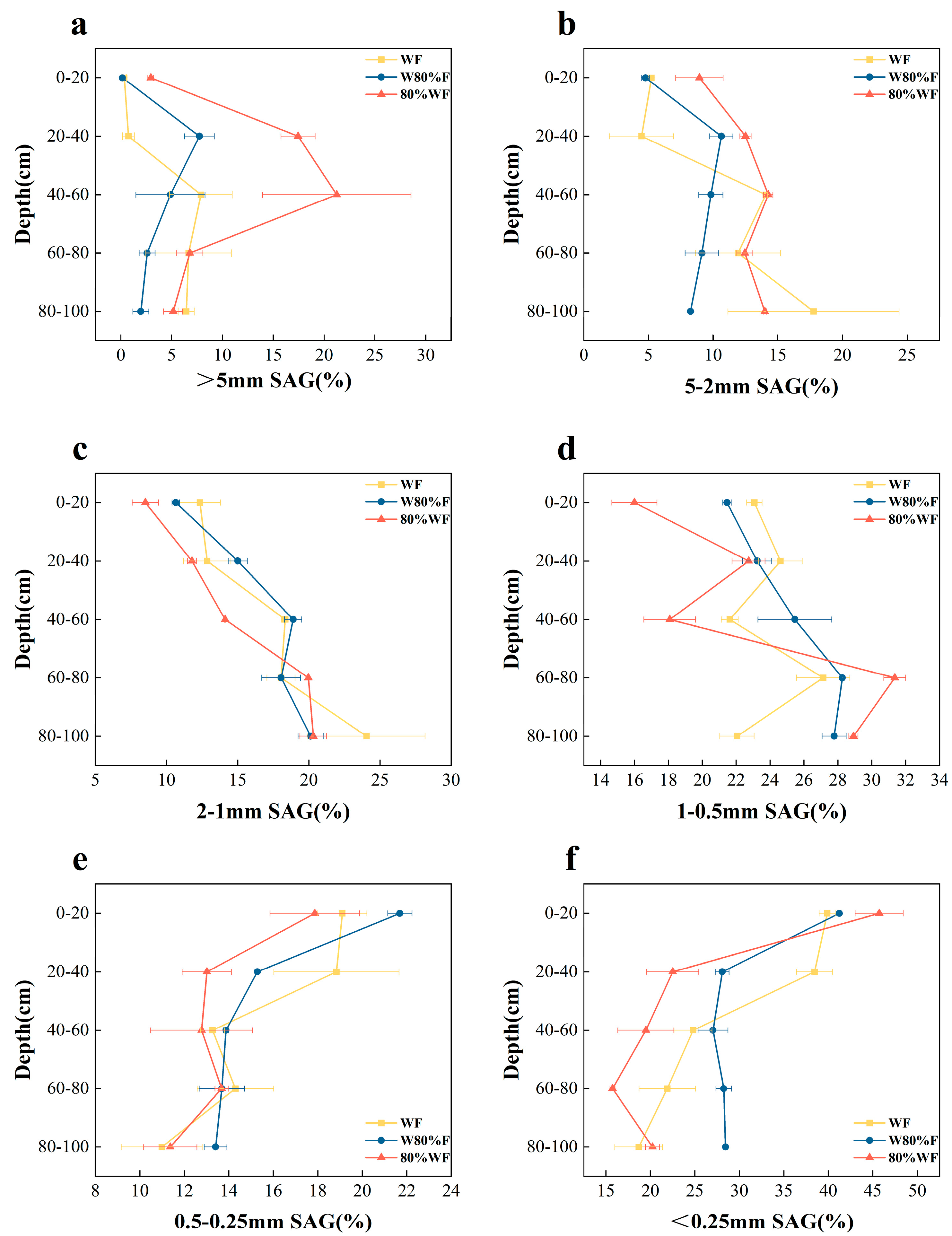
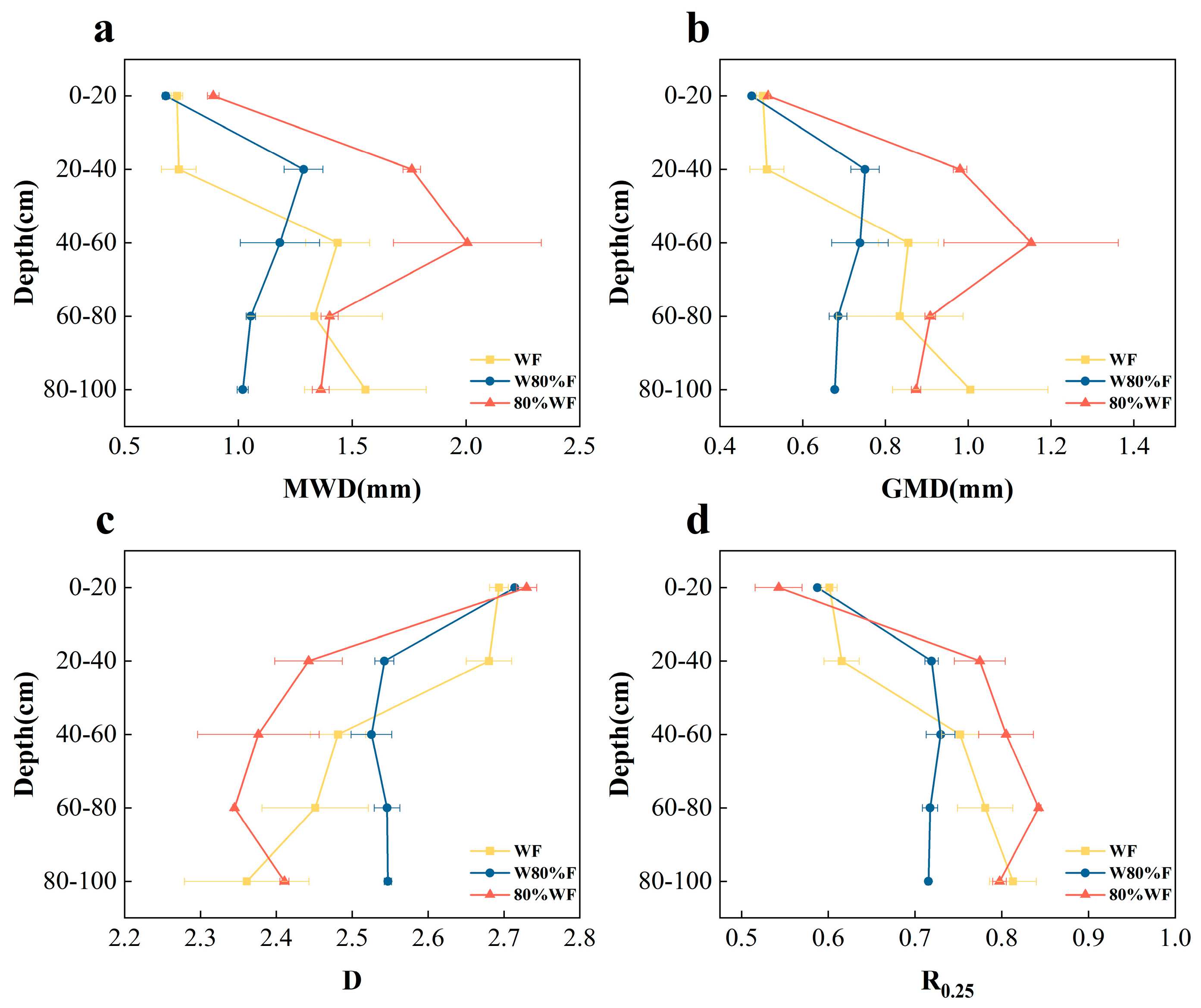
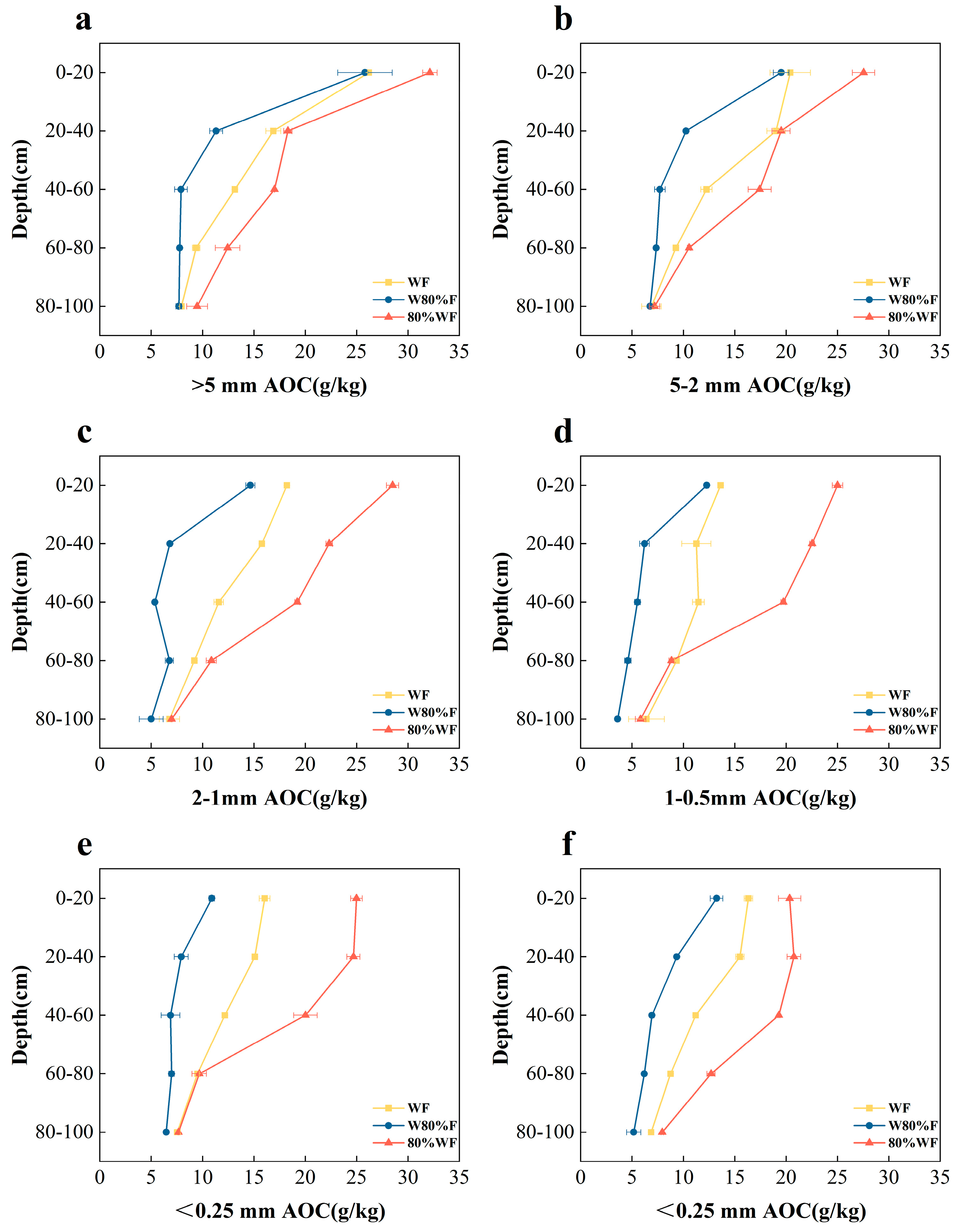
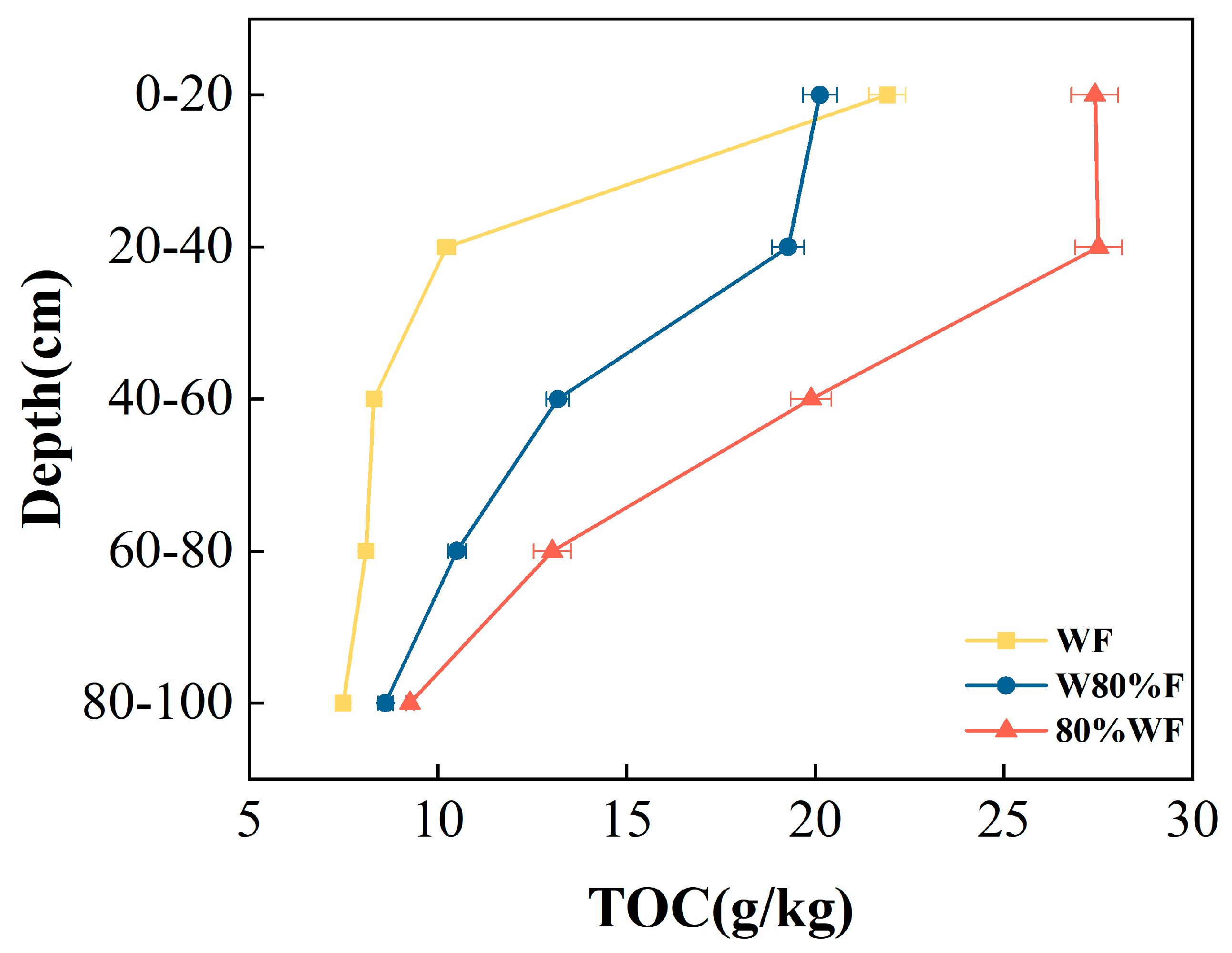
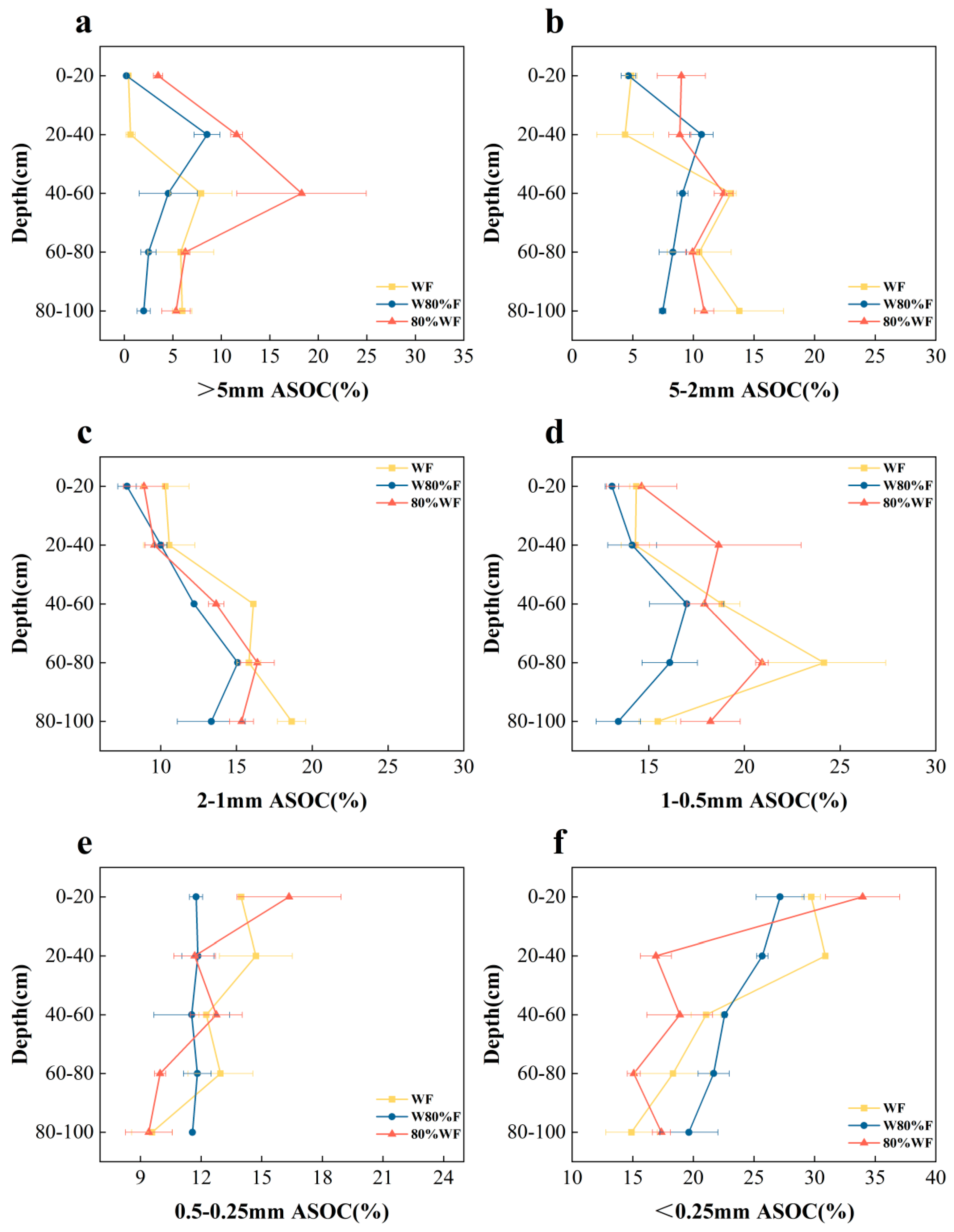


Disclaimer/Publisher’s Note: The statements, opinions and data contained in all publications are solely those of the individual author(s) and contributor(s) and not of MDPI and/or the editor(s). MDPI and/or the editor(s) disclaim responsibility for any injury to people or property resulting from any ideas, methods, instructions or products referred to in the content. |
© 2025 by the authors. Licensee MDPI, Basel, Switzerland. This article is an open access article distributed under the terms and conditions of the Creative Commons Attribution (CC BY) license (https://creativecommons.org/licenses/by/4.0/).
Share and Cite
Wu, K.; Li, W.; Hu, J.; Guan, S.; Yang, M.; Chen, Y.; Sui, Y.; Jiao, X. Effects of Water–Fertilizer Management on Soil Aggregate Stability and Organic Carbon Sequestration in Greenhouse Eggplant Fields of the Black Soil Region. Agronomy 2025, 15, 2672. https://doi.org/10.3390/agronomy15122672
Wu K, Li W, Hu J, Guan S, Yang M, Chen Y, Sui Y, Jiao X. Effects of Water–Fertilizer Management on Soil Aggregate Stability and Organic Carbon Sequestration in Greenhouse Eggplant Fields of the Black Soil Region. Agronomy. 2025; 15(12):2672. https://doi.org/10.3390/agronomy15122672
Chicago/Turabian StyleWu, Ke, Wanting Li, Jinxin Hu, Shiyang Guan, Mengya Yang, Yimin Chen, Yueyu Sui, and Xiaoguang Jiao. 2025. "Effects of Water–Fertilizer Management on Soil Aggregate Stability and Organic Carbon Sequestration in Greenhouse Eggplant Fields of the Black Soil Region" Agronomy 15, no. 12: 2672. https://doi.org/10.3390/agronomy15122672
APA StyleWu, K., Li, W., Hu, J., Guan, S., Yang, M., Chen, Y., Sui, Y., & Jiao, X. (2025). Effects of Water–Fertilizer Management on Soil Aggregate Stability and Organic Carbon Sequestration in Greenhouse Eggplant Fields of the Black Soil Region. Agronomy, 15(12), 2672. https://doi.org/10.3390/agronomy15122672




